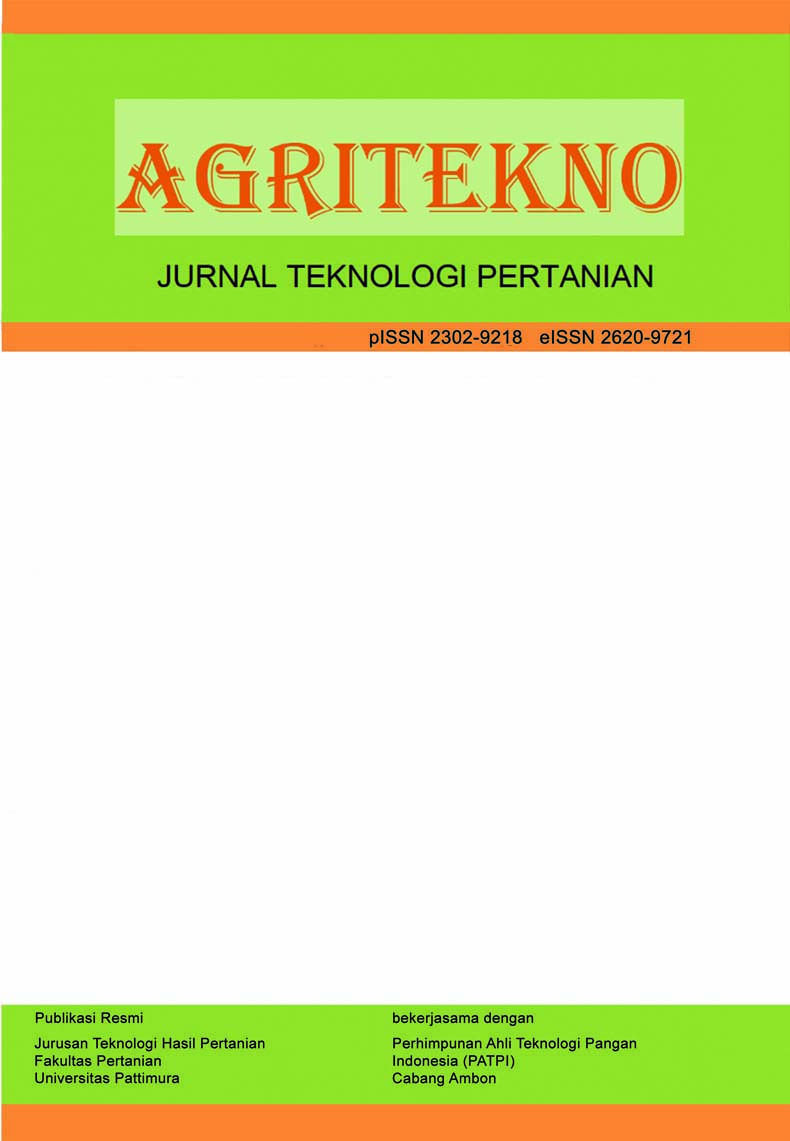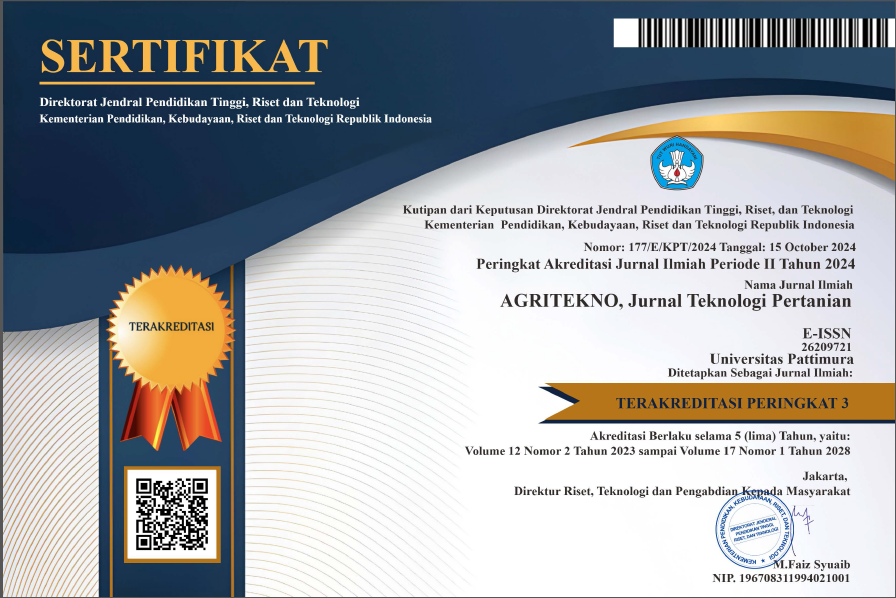Masa Depan dan Pengembangan Bioetanol di Indonesia
The Future and Development of Bioethanol in Indonesia
Abstract
Bioethanol plays a crucial role in Indonesia’s development, given its wide application across various industries, such as food, chemicals, pharmaceuticals, cosmetics, and alternative fuel. The diversity of feedstocks available for bioethanol production ranging from food crops, lignocellulose, food waste, to microalgae reflects positive advancements in production technologies. This study examines several aspects of bioethanol, including its historical development, the specifications applied in Indonesia, feedstock types, and the current demand for bioethanol in the country. The primary aim of this research is to identify the most promising feedstocks for large-scale bioethanol production in Indonesia. The methodology employed is a narrative literature review, drawing from 37 journal articles, 8 thesis documents, 7 web articles, and 2 publications from Badan Statistik Nasional. The analysis identifies the best feedstocks for bioethanol production in Indonesia, highlighting macroalgae, microalgae, and food waste as having significant potential to support the sustainable growth of the bioethanol industry in the future.
Downloads
References
Afrizal, D.R. (2014). Motivasi Brazil melakukan kerjasama pengembangan bioetanol dengan Indonesia tahun 2007-2012. Jurnal Online Mahasiswa Fakultas Ilmu Sosial Dan Ilmu Politik Universitas Riau, 1, 1169–1180.
Alzeer, J., & Hadeed, K.A. (2016). Ethanol and its Halal status in food industries Jawad. Trends in Food Science & Technology, 58, 14-20. https://doi.org/10.1016/j.tifs.2016.10.018
Badan Standardisasi Nasional. (2012). Bioetanol Terdenaturasi untuk Gasohol. SNI 7390:2012.
Badan Standarisasi Nasional. (2009). Etanol nabati. 1–11.
Badan Pusat Statistik (2014). Statistik Indonesia. Jakarta: BPS
BPS (2021). Statistik Indonesia. Jakarta: BPS
Baharum, N.B., Daud Awang, M., Arshad, S., & Abd Gani, S.S. (2020). A Study of literatures: status of alcohol in cosmetics products from shariah views in Malaysia. KnE Social Sciences, (October). https://doi.org/10.18502/kss.v4i9.7338
Bora, P., Das, P., Bhattacharyya, R., Barooah, M. S., & Saikia Barooah, M. (2019). Biocolour: The natural way of colouring food. Journal of Pharmacognosy and Phytochemistry, 8(3), 3663–3668.
Christian, M., & Putra, N.P. (2018). Perencanaan pabrik tugas akhir prarencana pabrik etil eter dari etanol. Universitas Katolik Widya Mandala.
Dahiya, D., & Nigam, P.S. (2018). Bioethanol synthesis for fuel or beverages from the processing of agri-food by-products and natural biomass using economical and purposely modified biocatalytic systems. AIMS Energy, 6(6), 979–992. https://doi.org/10.3934/ENERGY.2018.6.979
Darojati, H.A., Putra, S., & Zulprasetya, F.P. (2019). Pengaruh iradiasi gamma pada konversi biomassa lignoselulosa sabut kelapa menjadi bioetanol. Jurnal Teknik Kimia Dan Lingkungan, 3(2), 87–94. https://doi.org/10.33795/jtkl.v3i2.121
de Andrade Lima, M., Charalampopoulos, D., & Chatzifragkou, A. (2018). Optimisation and modelling of supercritical CO2 extraction process of carotenoids from carrot peels. Journal of Supercritical Fluids, 133, 94–102. https://doi.org/10.1016/j.supflu.2017.09.028
Fatimah, S., Arifan, F., Wisnu, B., & Noviana, S.N. (2021). Pemanfaatan kulit kentang dalam pembuatan bioetanol dengan metode hidrolisa asam di Desa Sikunang. Jurnal Penelitian Terapan Kimia, 2(1), 12–20. https://ejournal2.undip.ac.id/index.php/pentana/article/view/15075
Gunardi, A.J. (2023). Ketahui kadar alkohol di dalam berbagai jenis minuman keras. Retrieved June 11, 2024, from Klikdokter website: https://www.klikdokter.com/info-sehat/gigi-mulut/ketahui-kadar-alkohol-di-dalam-berbagai-jenis-minuman-keras
Guntama, D., Herdiana, Y., Sujiana, U.A., Endes, R.L., & Sunandar, E. (2019). Bioethanol dari limbah kulit singkong (Manihot esculenta Crantz) melalui metode hidrolisa dan fermentasi dengan bantuan Saccharomyces cerevisiae. Jurnal Teknologi, 7(1), 86–96. https://doi.org/10.31479/jtek.v7i1.35
Hakim, A.N. (2023). Pra rencana pabrik dietil eter dari etanol dan asam sulfat dengan proses dehidrasi etanol kapasitas produksi 50.000 ton/tahun. Institut Teknologi Nasional Malang.
Hans, M., Lugani, Y., Chandel, A.K., Rai, R., & Kumar, S. (2023). Production of first- and second-generation ethanol for use in alcohol-based hand sanitizers and disinfectants in India. Biomass Conversion and Biorefinery, 13(9), 7423–7440. https://doi.org/10.1007/s13399-021-01553-3
Hawusiwa, E.S., Wardani, A.K., & Ningtyas, D.W. (2015). Pembuatan minuman wine singkong. Jurnal Pangan Dan Agroindustri, 3(1), 147–155.
Hutagalung, J.M., Murdikaningrum, G., Yulianti, M., & Nurcahyani, S. (2023). Potensi limbah kulit dan biji rambutan (Nephelium lappaceum L) sebagai bioetanol. Composite: Jurnal Ilmu Pertanian, 5(2), 76–85. https://doi.org/10.37577/composite.v5i2.578
Iram, A., Berenjian, A., & Demirci, A. (2021). A review on the utilization of lignin as a fermentation substrate to produce lignin-modifying enzymes and other value-added products. Molecules, 26(10). https://doi.org/10.3390/molecules26102960
Irhamni, I., Diana, D., Saudah, S., Ernilasari, E., Suzanni, M.A., Mulyati, D., & Hakim, L. (2019). Fermentasi limbah kulit durian menjadi cuka organik dengan menggunakan Acetobacter aceti. Elkawnie, 5(1), 16–20. https://doi.org/10.22373/ekw.v5i1.3902
Jannah, A.M., Yerizam, M., Pratama, M.Y., & Amin, A.R.A. (2023). Pembuatan bioetanol berbahan baku Chlorella pyrenoidosa dengan metode hidrolisis asam dan fermentasi. Journal of Chemical Process Engineering, 8(1), 17–23. https://doi.org/10.33536/jcpe.v8i1.1256
Le Daré, B., & Gicquel, T. (2019). Therapeutic applications of ethanol: A review. Journal of Pharmacy and Pharmaceutical Sciences, 22, 525–535. https://doi.org/10.18433/JPPS30572
Liu, C., Li, K., Wen, Y., Geng, B., & Liu, Q. (2019). Bioethanol : New opportunities for an ancient product. In Advances in Bioenergy (1st ed.). Elsevier Inc. https://doi.org/10.1016/bs.aibe.2018.12.002
Liu, L., Wang, J., Rosenberg, D., Zhao, H., Lengyel, G., & Nadel, D. (2018). Fermented beverage and food storage in 13,000 y-old stone mortars at Raqefet Cave, Israel: Investigating Natufian ritual feasting. Journal of Archaeological Science: Reports, 21, 783–793. https://doi.org/10.1016/j.jasrep.2018.08.008
Liu, Y., Fang, J., Tong, X., Huan, C.C., Ji, G., Zeng, Y., Xu, L. & Yan, Z. (2019). Change to biogas production in solid-state anaerobic digestion using rice straw as substrates at different temperatures. Bioresource Technology, 293, 122066. https://doi.org/10.1016/j.biortech.2019.122066
Madhu. (2019). Difference Between Ethanol and Bioethanol. Retrieved May 20, 2024, from https://www.differencebetween.com/difference-between-ethanol-and-bioethanol/
Ma’mun, S., Prasetio, M.W., Anugrah, A.R., Ruliandi, A.P., & Pramuwardani, D. (2024). Bioethanol from Arthrospira platensis biomass using a combined pretreatment. Chemical Engineering Journal Advances, 19, 100616.
Mugasundari, A.V., & Anandakumar, S. (2022). Shelf life extension of bread using ethanol emitters with different packaging materials. Journal of Food Processing and Preservation, 46(12). https://doi.org/10.1111/jfpp.17143
Mussatto, S.I., Dragone, G., Guimarães, P.M.R., Silva, J.P.A., Carneiro, L.M., Roberto, I.C., Vicente, A., Domingues, L., & Teixeira, J.A. (2010). Technological trends, global market, and challenges of bio-ethanol production. Biotechnology Advances, 28, 817 – 830.
Nedstar. (n.d.). Industrial alcohol by Nedstar. Retrieved from https://www.nedstar.com/industries/main-industries/industrial-ethanol
Nell, C.D. (2022). Cosmetic advancement at the make-up of ethanol. Retrieved May 19, 2024, from https://isolvents.co.za/blogs/ethanol-articles/cosmetic-advancement-at-the-make-up-of-ethanol
Ngapa, Y.D., & Gago, J. (2020). Efektivitas zeolit alam Ende-NTT sebagai adsorben dalam pemurnian bioetanol berbahan baku moke: Minuman tradisional Flores. Jurnal Teknik Kimia Dan Lingkungan, 4(2), 121–127. https://doi.org/10.33795/jtkl.v4i2.137
Niphadkar, S., Bagade, P., & Ahmed, S. (2017). Bioethanol production : insight into past, present and future perspectives. Biofuels, 9(2), 229–238. https://doi.org/10.1080/17597269.2017.1334338
Ogidi, C.O., George, O.H., Aladejana, O.M., Malomo, O., & Famurewa, O. (2020). Fruit preservation with bioethanol obtained from the fermentation of brewer’s spent grain with saccharomyces carlsbergensis. Revista Facultad Nacional de Agronomia Medellin, 73(3), 9321–9331. https://doi.org/10.15446/rfnam.v73n3.85316
Oh, J., & Kim, M.K. (2021). Effect of alternative preservatives on the quality of rice cakes as halal food. Foods, 10(10), 1–9. https://doi.org/10.3390/foods10102291
PIB College. (2022). Dukung perkembangan industri food & beverage, PIB College gelar kelas arak dan tuak khas Bali. Retrieved June 11, 2024, from PIB College website: https://pib.ac.id/id/dukung-perkembangan-industri-food-beverage-pib-college-gelar-kelas-arak-dan-tuak-khas-bali/#:~:text=Tuak merupakan Tipe B dengan,Gin%2C Vodka%2C dan Tequila.
Portal Informasi Indonesia (2023). Menguji konsumsi bioetanol di tanah air. https://indonesia.go.id/kategori/editorial/7268/menguji-konsumsi-bioetanol-di-tanah-air?lang=1. [Diakses 01 Desember 2024]
Purnama, A.H. (2023). Prarancangan pabrik etil akrilat dari asam akrilat dan etanol dengan kapasitas 35.000. Universitas Lampung.
Rachmawan, V.J. (2014). Prarancangan pabrik etil asetat dari asam asetat dan etanol dengan katalis asam sulfat kapasitas 45.000 ton per tahun. Universitas Muhammadiyah Surakarta.
Rahayu, A.C. (2024). Kebutuhan bioetanol akan melonjak, kerja sama Indonesia-Brasil diperkuat. Retrieved May 29, 2024, from Kontan.co.id website: https://industri.kontan.co.id/news/kebutuhan-bioethanol-akan-melonjak-kerja-sama-indonesia-brasil-diperkuat
Rasyid, Z.W. (2022). Prarancangan pabrik etil asetat dari asam asetat dan etanol dengan reactive tividing wall column kapasitas 16.000 Ton. (Universitas Diponegoro). Universitas Diponegoro. Retrieved from https://eprints2.undip.ac.id/id/eprint/12943/1/S_Muhammad Aqil Hasani.pdf
Reldian, R.R., & Setyati, W. (2020). Prarancangan pabrik etil akrilat dari asam akrilat dan etanol kapasitas produksi 4.000 ton/tahun. Universitas Islam Indonesia.
Rifa’i, A.F., Pamungkas, W.A., Setyawati, R.B., Setiawan, C.P., & Waluyo, J. (2022). Kajian teknoekonomi bioetanol berbahan molasses sebagai alternatif substitusi BBM. Equilibrium Journal of Chemical Engineering, 6(1), 61. https://doi.org/10.20961/equilibrium.v6i1.63158
Sasma. (n.d.). Synthetic anhydrous 99%. Retrieved May 20, 2024, from Sasma website: https://sasmabv.com/products/synthetic-anhydrous-99/
Sen, K., Mukherjee, R., Sansare, S., Halder, A., Kashi, H., Ma, A.W.K., & Chaudhuri, B. (2021). Impact of powder-binder interactions on 3D printability of pharmaceutical tablets using drop test methodology. European Journal of Pharmaceutical Sciences, 160, 105755. https://doi.org/10.1016/j.ejps.2021.105755
Setiawan, L., Azzahra, N.A., & Budhijanto. (2022). Prarancangan pabrik etil akrilat dari etanol dan asam akrilat kapasitas 50.000 ton/tahun. Yogyakarta.
Shalita, A. (2024). Aplikasi controlled-release ethanol emitter dan cinnamon oil sebagai kemasan aktif antimikroba produk roti. Institut Pertanian Bogor. Retrieved from https://repository.ipb.ac.id/handle/123456789/150466#:~:text=Ethanol emitter (EE) merupakan kemasan,memperpanjang umur simpan roti manis.
SIPSN (2024). Komposisi sampah. https://sipsn.menlhk.go.id/sipsn/public/data/komposisi. [Diakses 01 Desember 2024]
Sousa, I.G. de. (2021). Impact of ethanol treatment on the technological characteristics, nutritional composition, and bioactivity of gluten-free breads produced with different microalgae. Universidade de Lisboa.
Syariena, A., & Puziah, H. (2014). Rapid determination of residual ethanol in perfumery products using headspace gas chromatography-mass spectrometry. Middle-East Journal of Scientific Research, 22(3), 432–437. https://doi.org/10.5829/idosi.mejsr.2014.22.03.21906
Thakur, M., & Modi, V.K. (2022). Biocolorants in food: Sources, extraction, applications and future prospects. Critical Reviews in Food Science and Nutrition, 64(14), 4674–4713. https://doi.org/10.1080/10408398.2022.2144997
Waluyo, D. (2024). Menilik potensi bioetanol Indonesia, ada 13 produsen di 11 wilayah. https://katadata.co.id/ekonomi-hijau/energi-baru/6678ed2c25dd1/menilik-potensi-bioetanol-indonesia-ada-13-produsen-di-11-wilayah. [Diakses 01 Desember 2024]
Wardiyah. (2016). Kimia organik (1st ed.). Kementrian Kesehatan Republik Indonesia. Retrieved from https://elearning.itkesmusidrap.ac.id/mod/resource/view.php?id=4098
Wiratmaja, I.G., & Elisa, E. (2020). Kajian peluang pemanfaatan bioetanol sebagai bahan bakar utama kendaraan masa depan di Indonesia. Jurnal Pendidikan Teknik Mesin Undiksha, 8(1), 1–8. https://doi.org/10.23887/jptm.v8i1.27298
Wusnah, B. S., & Hartono, D. (2019). Proses pembuatan bioetanol dari kulit pisang kepok (Musa acuminata B.C.) secara fermentasi. Jurnal Teknologi Kimia Unimal, 1, 48–56.
Yuniarti, D.P., Hatina, S., & Efrinalia, W. (2018). Pengaruh jumlah ragi dan waktu fermentasi pada pembuatan bioetanol dengan bahan baku ampas tebu. Jurnal Redoks, 3(2), 1–12. https://doi.org/10.31851/redoks.v3i2.2391
Copyright (c) 2024 The Author(s)

This work is licensed under a Creative Commons Attribution-ShareAlike 4.0 International License.
Authors who publish with this journal agree to the following terms:
- Authors retain copyright and grant the journal the right of first publication with the work simultaneously licensed under a Creative Commons Attribution License that allows others to share the work with an acknowledgement of the work's authorship and initial publication in this journal.
- Authors are able to enter into separate, additional contractual arrangements for the non-exclusive distribution of the journal's published version of the work (e.g., post it to an institutional repository or publish it in a book), with an acknowledgement of its initial publication in this journal.
- Authors are permitted and encouraged to post their work online (e.g., in institutional repositories or on their website) prior to and during the submission process, as it can lead to productive exchanges, as well as earlier and greater citation of published work (See The Effect of Open Access).









